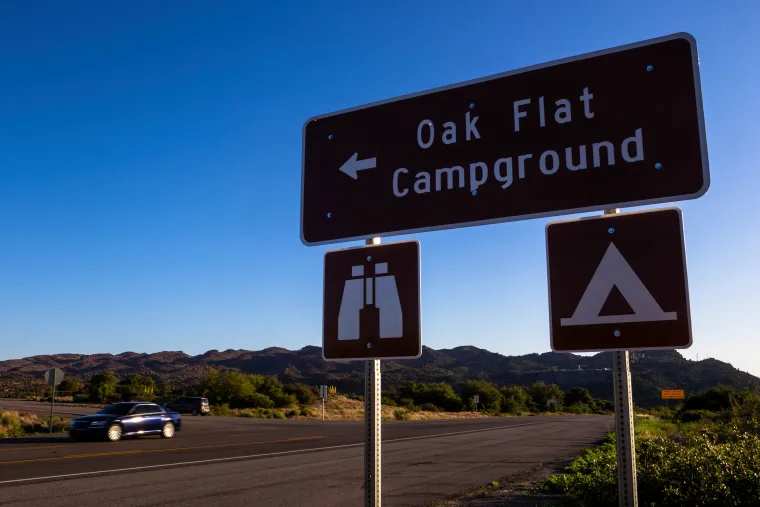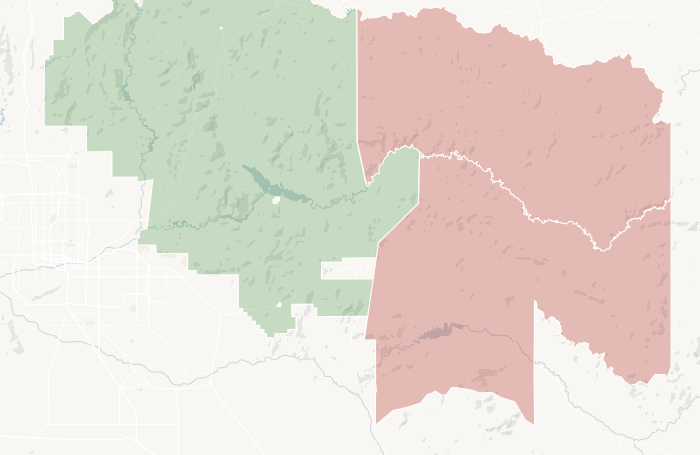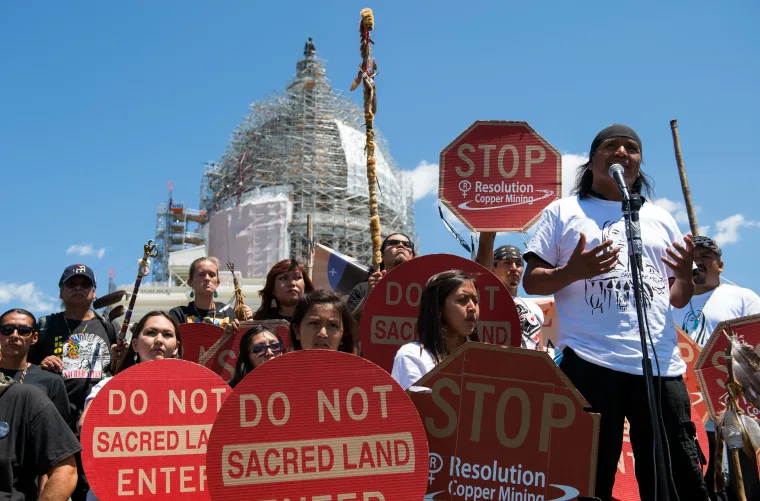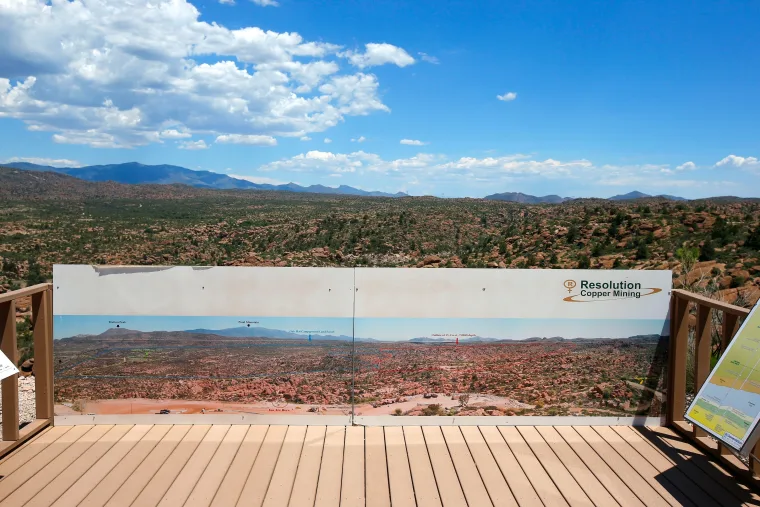The billboard project is expanding to Oregon
Historic Arizona mining town backs copper project
Residents of a town in central Arizona are engaged in a tug of war with Native groups over a huge copper mine that's been proposed on national forest land
Anita Snow
Associated Press

Apache Leap Mountain hovers over Superior, Ariz., Friday, June 9, 2023. The historic mining town in central Arizona is the subject of a tug of war between locals who want a copper mine developed nearby for economic benefit and Native American groups who say the land needed for mining is sacred and should be protected. (AP Photo/Matt York)
Growing up in a mining family that goes back generations, Mayor Mila Besich knew the Oak Flat Campground as the place where she attended union picnics as a girl and in earlier years her parents stood in a clearing to hear the World Series on the radio.
Now, Besich is overseeing Superior’s fight to build a new copper project at Oak Flat amid worries about the town’s economic future.
Today, the national forest land in the heart of Arizona’s “Copper Corridor” is scattered with 20 rustic campsites among ancient oaks and a hand-painted sign that reads: “Protect Oak Flat, Holy Land.” Buried deep underground is the world’s third-largest deposit of copper ore, big enough to yield 40 billion pounds of the metal over 60 years.
Competing interests have ignited a tug of war between the town of about 3,000 people who want a huge copper mine built there for its economic benefits, and Native groups that consider the land sacred and are fighting to protect it from disturbance.
“Our town is going to be the most affected,” said the mayor. “What about our culture?”

Resolution Copper Mining, a joint subsidiary of U.K. and Australian mining giants Rio Tinto and BHP, hopes to build one of the world’s largest underground copper mines at the site outside Superior, about 70 miles east of Phoenix. Managing partner Rio Tinto says the mine could satisfy a quarter of growing U.S. demand for copper used in electric vehicles and smartphones.
Resolution began the permitting process nearly a decade ago, but the project has been delayed amid legal and political wrangling between U.S. agencies and the nonprofit Apache Stronghold, which challenges a planned land swap that would make the project possible. The full U.S. 9th District Court of Appeals is considering Apache Stronghold’s request to permanently halt the project, but the only thing stopping it now is the lack of a new environmental impact statement.
Two other lawsuits challenging the initial environmental review, one filed by the San Carlos Apache Tribe and the other by environmental groups, have gone nowhere since the U.S. government pulled the impact statement for more consultations.
Oak Flat is on Tonto National Forest property to be conveyed to Resolution under a land exchange that Congress approved in a 2014 rider to a must-pass defense bill.

The congressional vote sparked outrage among some Apaches over the site, which features ancient Emory oaks and their acorns and other plants they consider important to their culture and religion. Called Chi’chil Bildagoteel, the site is about an hour’s drive from the San Carlos Apache Reservation and has been used for girls’ coming-of-age celebrations.
Rio Tinto has said it would keep the campground open during the mine’s first decades of operation. But Oak Flat could eventually collapse into a 1.8-mile crater when massive amounts of rock are removed from below.
Wendsler Nosie, a former San Carlos Apache tribal chairman and longtime activist, is the face of the Save Oak Flat campaign. He earlier fought unsuccessfully to stop a major telescope project on a site in southeastern Arizona that Apaches consider sacred: Mount Graham, or Dzil Nchaa Sí’an.
Nosie said he believes many townspeople quietly back his fight, but “they cannot openly show their support for me.”
When he was recently confronted in an area restaurant by a mining company employee who accused him of endangering jobs, development and good schools, “I stood up and talked about how I’m fighting for land, the water, the earth, religion and our children,” he said, prompting a group of diners to applaud and pay for his dinner.

While the San Carlos Apache leadership opposes the mine, some tribe members support it for the jobs it could generate amid high unemployment on the reservation.
“Oak Flat is not sacred,” said Karen Kitcheyan-Jones, 64, a citizen who lives on the reservation. “There are many places on the reservation where we can gather acorns and have ceremonies.”
Brenda Astor, Resolution’s principal adviser for Native affairs and a San Carlos Apache citizen, noted that dozens of other enrolled citizens also work for the mining company.
Amid strong opposition to the project by some tribes and others, the Forest Service withdrew Resolution’s original environmental impact statement for Oak Flat two years ago for additional consultations. No time frame has been announced. But once a new review is published, the formal transfer process can begin unless a federal court halts it.
U.S. Rep. Raul Grijalva of Arizona reintroduced legislation in March seeking to stop the land transfer, but it has not gained traction in Congress.
Rio Tinto says the mine would help create 3,700 jobs over the course of the project and boost state and local tax revenues by $88 million to $113 million a year.
That’s a lot for a town still clawing back economically after the Magma copper mine first shut down in 1982, later opened for a few years, then closed for good in 1996. The closure devastated a community so small that it has no stoplight and can be traversed by car in just over three minutes.
Superior was originally established in 1882 as the town of Hastings when the big mine was the Silver King, producing silver. The former mining towns of Globe and Miami are nearby, burrowed into mountains studded with saguaro cactus.

Today, Superior still embraces its labor roots, a Democratic island in predominantly Republican Pinal County, said Besich, herself a Democrat.
More than a quarter of the town’s residents live below the poverty line. Nearly 70 percent of the population is Hispanic, largely descendants of mining families who immigrated from Mexico or already worked in the area when it was still part of Mexico until the mid-1800s.
“We didn’t cross the border, it crossed us,” said Manny Guzman, whose family in the area goes back seven generations. His ancestor Manuelita Guzman (1844–1916) is buried in the Historic Pinal Cemetery, also the resting place of Wyatt Earp’s common-law wife, Mattie Earp.
Guzman, president of the nonprofit economic development corporation Rebuild Superior, said he remains hopeful the mine will prevail, but finds the delays frustrating after spending innumerable hours debating the environmental review.
“There have been so many studies, so many roundtables,” he said.
The talks have secured important gains for Superior, such as ensuring protection of the town’s water supply and guaranteeing a minimum of $120 million in revenue to pay for police and fire services over the course of the project if it goes forward.
“We have seen some pretty dramatic changes to the plan,” said Vicky Peacey, Resolution’s president and general manager. “It’s important that a lot of voices are heard.”
Rio Tinto also agreed to permanently protect Apache Leap, the town’s backdrop where local legend says some 75 Apaches leapt 400 feet to their death in the early 1870s rather than surrender to the U.S. cavalry.
Town manager Todd Pryor said Resolution provided $2.25 million to help buy the old brick Superior High School that’s being renovated to house the town hall, a library and activities for seniors, and threw in another $1.29 million for an enterprise center to develop future entrepreneurs and teach people trades such as welding.
Officials in a town used to boom and bust cycles say they know they need to diversify their economy and can’t count only on Resolution and its mine for their future.
They are developing local tourism, every March hosting a popular Apache Leap Mining Festival that includes a parade, chihuahua races and a mining competition with hand-sawing and jackleg drilling contests. Hundreds visit the town each August for the Prickly Pear Festival, with cactus fruit ice cream and margaritas.
But in a state that produces 70 percent of the nation’s copper, and in a town where nearly everyone’s parents and grandparents worked for the mines, the biggest bets for the future are on the extraction of ore.
“It’s in our DNA,” said Rick Cartier, the chamber of commerce president.
Here is how developments have played out over nearly a decade:
November 2013: Resolution Copper introduces its initial general plan of operations for a proposed mine at Oak Flat.Dec. 12, 2014: The U.S. Senate approves a must-pass military spending bill that included the Oak Flat land swap, giving the national forest property to mining companies for development of America’s largest copper mine. A rider tucked into the legislation called for Resolution Copper to get 3.75 square miles (9.71 square kilometers) of forest land in return for eight parcels it owns in Arizona.March 4, 2016: The Forest Service adds Oak Flat to the National Register of Historic Places. Arizona Republican Congressman Paul Gosar and Democratic Rep. Ann Kirkpatrick oppose the historic place designation, with Gosar saying it is “sabotaging an important mining effort.”May 24, 2020: A Rio Tinto iron mining project destroys two rock shelters that were inhabited by Indigenous people for 46,000 years in Juukan Gorge in Western Australia state, prompting the resignation of the company CEO.Jan. 12, 2021: Apache Stronghold sues the federal government, saying the Forest Service cannot legally transfer the land to Rio Tinto for several parcels the company owns and maintains the land around Oak Flat was reserved for Western Apaches in an 1852 treaty with the U.S.Feb. 12, 2021: A federal judge rejects the request to keep the Forest Service from transferring the land to Resolution Copper. saying that because Apache Stronghold is not a federally recognized tribe it lacks standing to argue the land belongs to Apaches.March 1, 2021: The U.S. Department of Agriculture pulls back an environmental review that had cleared the way for the land swap, saying it needed more time to consult with Native American tribes and othersOct. 21, 2021: Apache Stronghold asks a three member panel of the 9th U.S. Circuit Court of Appeals to keep Rio Tinto from getting the Oak Flat property. Months later, the panel issues a 2-1 decision that the federal government can give the Oak Flat land to Rio Tinto, but then agrees to let a larger appeals panel hear the case.March 21, 2023: Apache Stronghold tells a full panel of the 9th U.S. Circuit Court of Appeals that the Resolution project would prevent Native American groups from exercising their religion by destroying land they consider sacred. The 11-member panel says it will issue a decision in the coming months.
External
Identification not yet made
UTTC International Powwow attendees share their rules for a fun and considerate event
Radio collaboration highlights importance of cooperation in a season of funding cuts for local media
A memorial in the Snow County Prison, now the United Tribes Technical College campus
Standing Rock Sioux Tribal Chairwoman Janet Alkire tells crowd, ‘We’re going to rely on each other’






